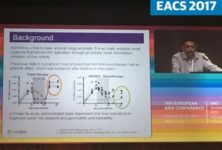An international group of researchers involved in the ANRS 12174 randomised controlled trial of pre-exposure prophylaxis (PrEP) for infants say that it is high time we started giving PrEP to all breastfed babies of HIV-positive mothers in countries where the likelihood of transmission via breastfeeding remains significant.
Dr Philippe van de Perre of the University of Montpellier in France and colleagues say that the rate of mother-to-child transmission, although it has fallen by over 50% since 2010, is still far too high in Africa. Infant HIV incidence in the children of HIV-positive mothers is 8.9% per year in the 21 countries in Africa most affected by HIV and has only been brought below 5% in five of them (Botswana, Namibia, Uganda, South Africa and Swaziland). The World Health Organization (WHO) has recommended offering PrEP to any population in which the expected annual incidence of HIV is over 3% and the writers say it violates the rights of infants to exclude them from this recommendation.
The WHO’s main strategy for preventing vertical (mother to baby) transmission of HIV is its “Option B+” strategy which recommends offering lifelong antiretroviral therapy (ART) to any woman with HIV who becomes pregnant or is diagnosed during pregnancy or breastfeeding. Option B+ also recommends six weeks of PrEP with the drug nevirapine for the newly born baby but breastfeeding usually continues well beyond this period. Of the 8.9% of babies in the 21 most-affected countries who acquire HIV through vertical transmission, 3.9% acquire HIV more than six weeks after birth, meaning that 44% of infections are occurring through breastfeeding after this point.
Not every pregnant or breastfeeding woman is offered ART under Option B+. This is partly due to logistics and difficulty in attending care, but many women do not know they have HIV, often because they acquire it after taking an antenatal HIV test. A 2015 study found that nearly 40% of breastfeeding women in South Africa, Malawi and Kenya had acquired HIV during pregnancy or breastfeeding, and the proportion of women with a viral load over 1000 copies/ml and therefore potentially infectious varied from 27% in Malawi to 73% in Kenya.
In addition, not every woman takes up the offer of lifelong ART or continues it if she does. In Malawi, 20% of women never started ART during the early phases of the introduction of Option B+ and in Swaziland, only 50% of women who started ART were still in the programme after a year. Women with higher CD4 counts and in better health were more likely to stop taking ART..
There are also biological reasons why PrEP for breastfed infants may be a good idea. Some researchers believe that a high proportion of vertical transmission during breastfeeding may be due to direct cell-to-cell transmission of HIV and not via the viral particles whose production is suppressed by ART. One model has estimated that the transmission rate from a woman with a suppressed viral load who continually breastfeeds is as high as 2.4% a year. One of the reasons PrEP may work so well is because it saturates potential target cells with antiretroviral drugs and proofs these immature, vulnerable cells against infection by both viral particles and direct transfer of viral material.
The ANRS 12174 trial reduced vertical transmission from mothers not taking ART to 0.5% a year and, significantly, one of the two drugs used was solo lamivudine (3TC) which is also a very cheap drug. Solo lamivudine PrEP could cost as little as $15 (£12) a year and drug levels observed in ANRS 12174 suggest that infants are protected from HIV transmission even at blood lamivudine levels significantly lower than those needed for treatment.
The big question is that if women do not want to take ART themselves, why would they administer it to their babies? They did so in ANRS 12174, where babies were given over 90% of their PrEP doses by their mothers, and the authors say that unpublished data suggests that the majority of women in that trial preferred the idea of giving their baby PrEP to taking ART themselves.
A simpler idea, however, given that lamivudine PrEP could potentially be so cheap, is that it should be given as routine to infants of all HIV-positive mothers as long as they are breastfed, whether the mother is on ART or not. Even if annual HIV incidence in breastfed infants not on PrEP was only 1%, the cost of lamivudine PrEP would be only $1500 per HIV infection averted, which is considerably less than the $6000 or so that ART alone, even at African prices of $100 a year, would cost for a lifetime’s treatment.
In addition, of course, those babies would not grow up living with HIV, and would not be at risk of suffering the social consequences of HIV infection or passing on HIV. Van de Perre and colleagues say that routine infant PrEP “could be a major breakthrough as a public health approach to eliminate mother-to-child transmission” and that “there is a moral imperative to correct the policy inequity that exists between HIV-exposed adults and children.”
Related News

Taking large numbers of non-ART drugs associated with increased risk of hospitalisation and death for HIV-positive people



 ПОИСК ПО САЙТУ
ПОИСК ПО САЙТУ  поиск по ресурсному центру
поиск по ресурсному центру 

